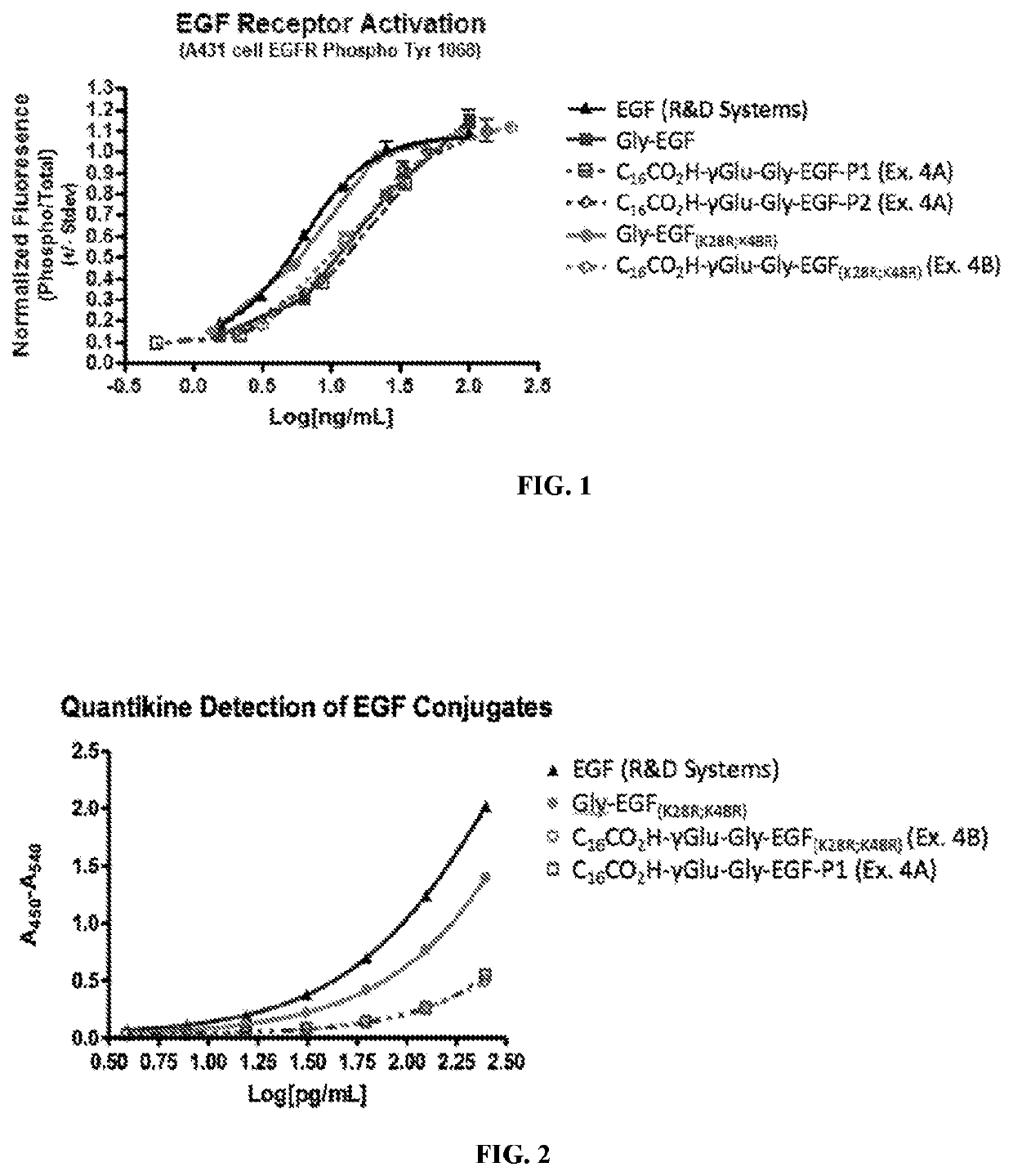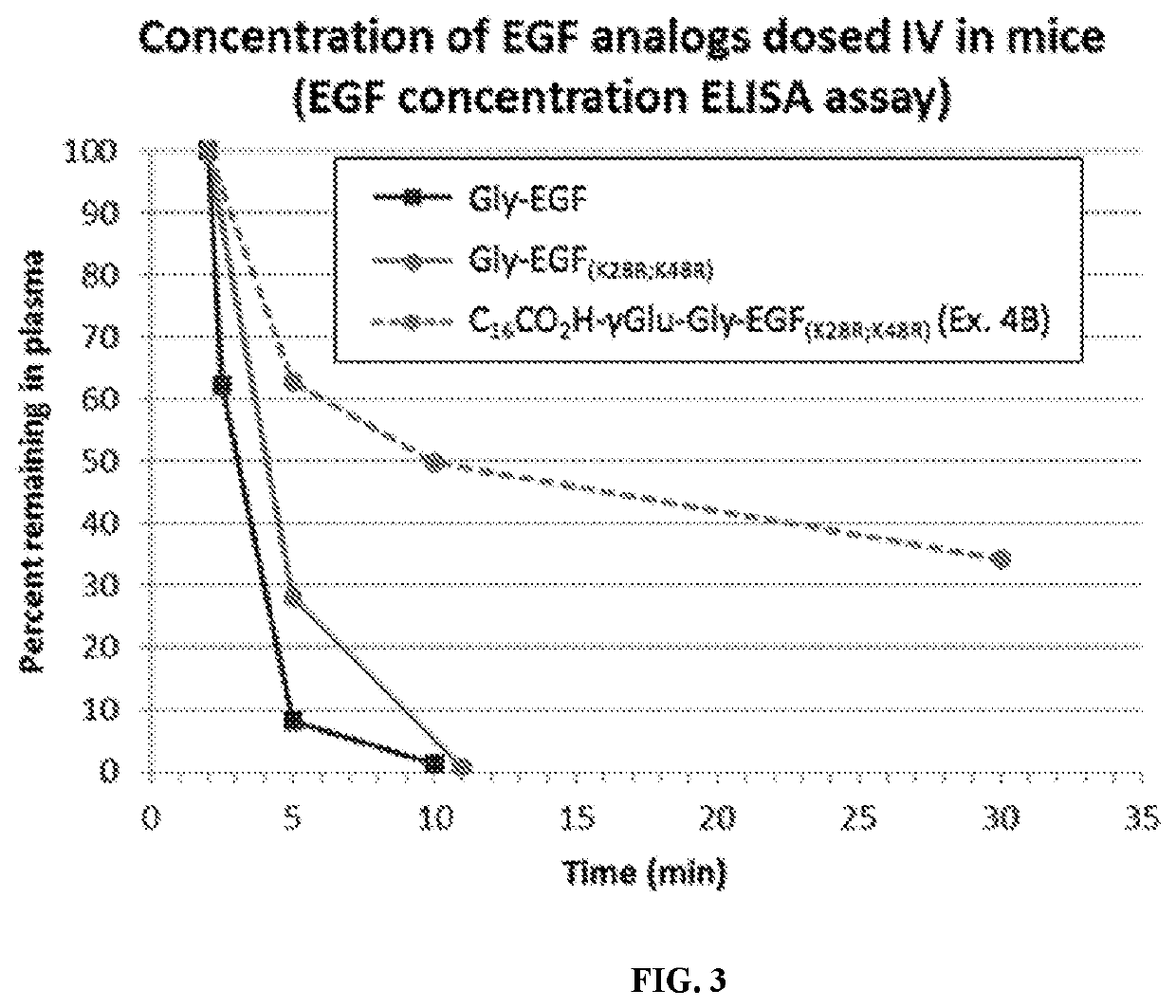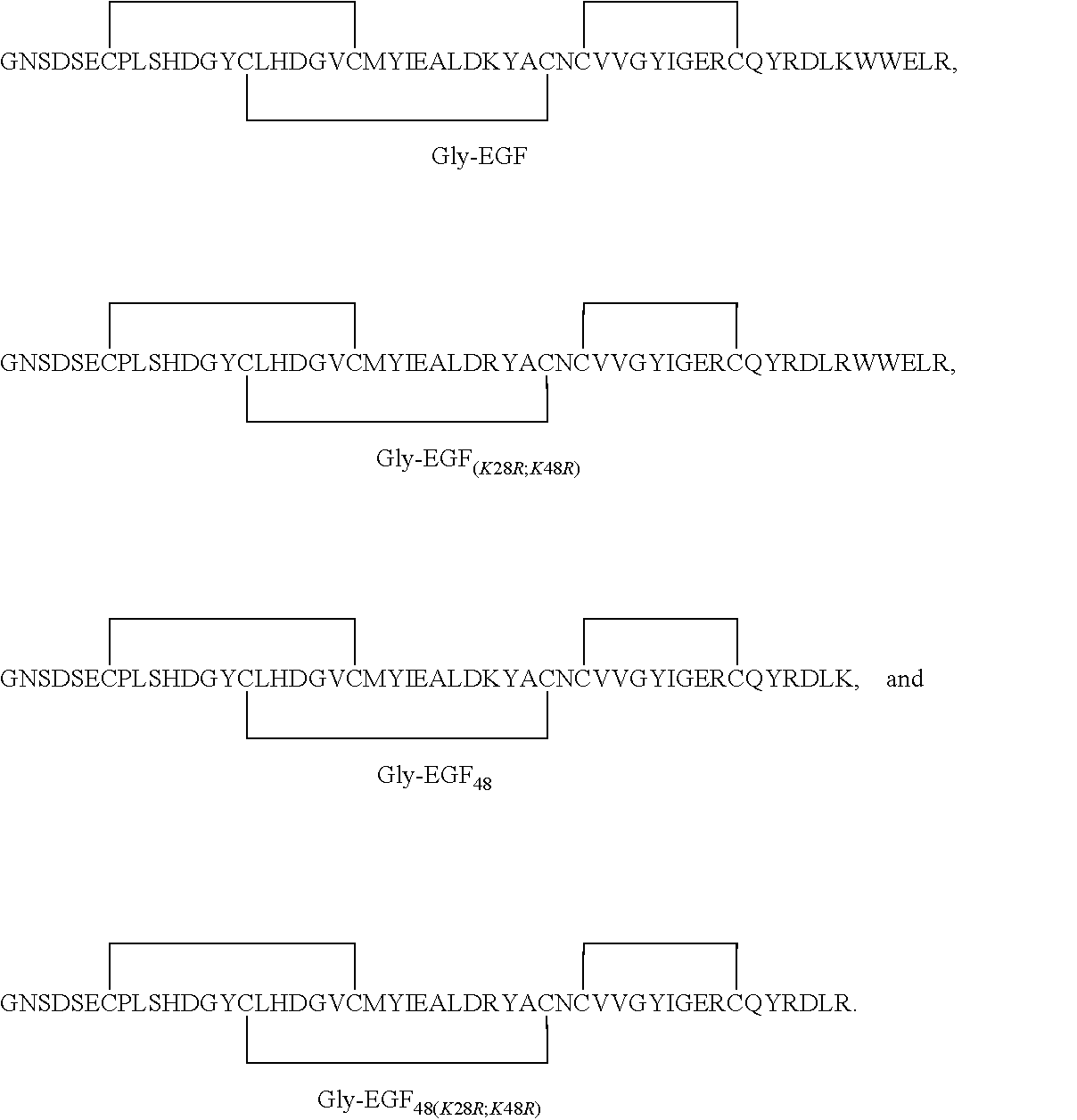Fatty acid modified human epidermal growth factor
a technology of egf and fatty acid modification, which is applied in the field of medicine, protein biology and biochemistry, can solve the problems of no cure for sgs, still suffer from severe diarrhea, weight loss and fatigue, and accompanied by dehydration, so as to facilitate drug absorption, enhance solubility, and reduce viscosity
- Summary
- Abstract
- Description
- Claims
- Application Information
AI Technical Summary
Benefits of technology
Problems solved by technology
Method used
Image
Examples
example 1
Instrumentation and General Methods
[0134]Commercially available reagents and solvents were used without further purification unless stated otherwise. LC-MS analyses of synthetic intermediates were performed on an Agilent 1100 electrospray mass spectrometer in positive ion mode with scan range was 100-1000d. Preparative normal phase chromatography was performed on a CombiFlash Rf+ (Teledyne Isco) with pre-packed RediSep Rf silica gel cartridges. Preparative reverse phase HPLC was performed on a CombiFlash Rf+(Teledyne Isco) equipped with RediSep Rf Gold pre-packed C18 cartridges and an acetonitrile / water / 0.05% TFA gradient unless stated otherwise. The retention time and purity of tested compounds was ≥90% as determined by HPLC analysis conducted on an Agilent 1100 system with diode array detector using an Ascentis Express Peptide ES-C18 2.7 micron, 30×4.6 mm reverse phase C18 column, using a 5 to 95% acetonitrile / water / 0.05% TFA gradient over 3 min at 2.5 mL / min unless stated otherwi...
example 2
on of Fatty Acid Conjugation Reagents
[0135]
Preparation of (S)-16-((1-carboxy-4-((2,5-dioxopyrrolidin-1-yl)oxy)-4-oxobutyl)amino)-16-oxohexadecanoic acid (7; C16CO2H-γGlu-OSu)
[0136]Step 1. 1,1-Di-tert-butoxy-N,N-dimethylmethanamine (5.0 mL, 21 mmol) was added slowly dropwise via addition funnel to a refluxing mixture of hexadecanedioic acid (2.2 g, 7.7 mmol) in toluene (15 mL). After refluxing overnight, the mixture was concentrated and absorbed to 10 grams of silica gel and purified by flash chromatography (0 to 100% ethyl acetate / hexanes) to furnish 16-(tert-butoxy)-16-oxohexadecanoic acid (2) as a white solid (1.3 g, 3.8 mmol, 49% yield). LCMS m / z 365 (MH+).
[0137]Step 2. 16-(tert-butoxy)-16-oxohexadecanoic acid (2) (1300 mg, 3.80 mmol) was dissolved in THF (13 mL) and treated successively with DIEA (0.780 ml, 4.55 mmol), 1-hydroxypyrrolidine-2,5-dione (524 mg, 4.55 mmol), and O—(N-Succinimidyl)-N,N,N′,N′-tetramethyluronium tetrafluoroborate (TSTU; 1371 mg, 4.55 mmol) and stirred o...
example 3
n and Purification of Gly-EGF Proteins
Preparation of Gly-EGF
[0141]
[0142]Synthetic DNA coding for hEGF with an N-terminal Gly (GNSDSECPLSHDGYCLHDGVCMYIEALDKYACNCVVGYIGERCQYRDLKWWELR (SEQ ID NO: 2)) was subcloned into pET32a(+) vector as an N-terminal thioredoxin fusion with a His6 tag for metal affinity purification, with a TEV protease recognition site for removal of fusion partner and affinity tag. The expression construct was placed into chemically competent Origami B (DE3) cells via heat shock, and transformants selected by antibiotic on LB agar plates (100 ug / mL carbenicillin). After cell growth and induction, the soluble fraction from the Origami B E. coli host strain was applied to a Co++ metal affinity column. After elution of the thioredoxin-EGF fusion protein with imidazole, TEV protease cleavage was used to remove the thioredoxin and His6 tags from rhEGF. This cleavage reaction mixture was reapplied to a reequilibrated Co++ column and the unbound fraction containing mature...
PUM
| Property | Measurement | Unit |
|---|---|---|
| molecular weight | aaaaa | aaaaa |
| pH | aaaaa | aaaaa |
| pharmaceutical composition | aaaaa | aaaaa |
Abstract
Description
Claims
Application Information
 Login to View More
Login to View More - R&D
- Intellectual Property
- Life Sciences
- Materials
- Tech Scout
- Unparalleled Data Quality
- Higher Quality Content
- 60% Fewer Hallucinations
Browse by: Latest US Patents, China's latest patents, Technical Efficacy Thesaurus, Application Domain, Technology Topic, Popular Technical Reports.
© 2025 PatSnap. All rights reserved.Legal|Privacy policy|Modern Slavery Act Transparency Statement|Sitemap|About US| Contact US: help@patsnap.com



